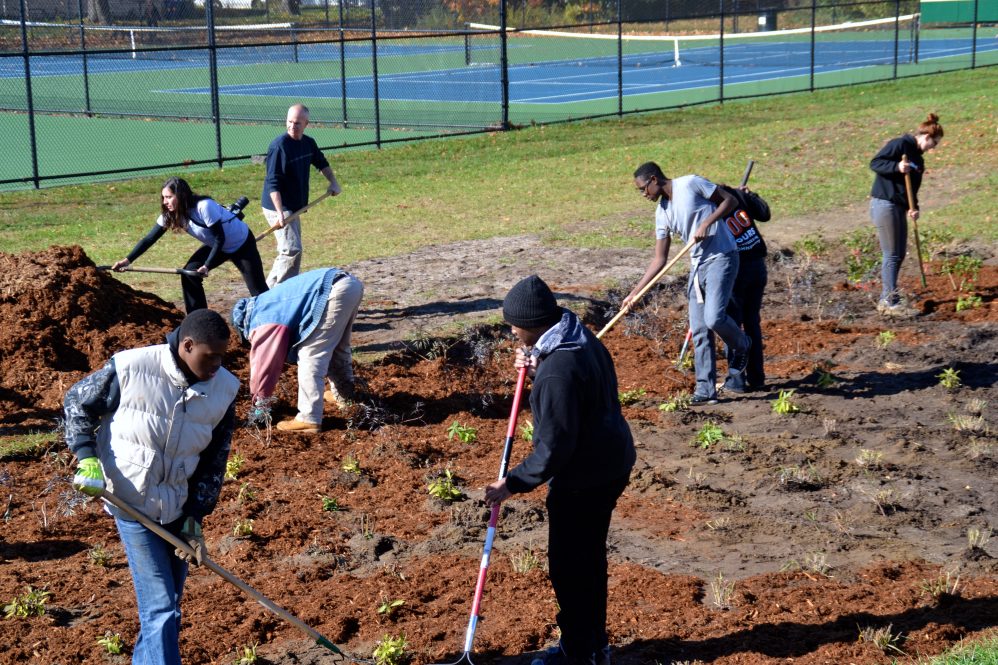As anyone who’s ever seen an overwhelmed storm drain or sloshed across a flooded sidewalk knows, urban development and heavy precipitation often combine to spell trouble for communities. But outside the land development field, few people are aware of existing stormwater management infrastructure and how they can implement local flooding solutions.
A team of environmental educators and professors within UConn Extension has recently been awarded a $100,000 grant from the Environmental Protection Agency (EPA) to carry out an innovative model of community-based education to help address this problem. The UConn team is partnering with school districts and NGOs in several of Connecticut’s disproportionately affected communities to create on-the-ground stormwater management solutions. In addition to mitigating storm damage and enriching local water quality, these solutions will provide valuable educational experiences in environmental stewardship.
“The students, the teachers, and the nonprofits all come together and – with our help – plan and then carry out a low-impact development project,” says Nicole Freidenfelds, project manager and Natural Resources Conservation Academy (NRCA) program coordinator. “It gets the students involved and seeing that they can make a change in their community and also benefit the environment.”
Rain gardens, bioswales, green roofs, and permeable pavements are all examples of projects that high schoolers may learn about or help implement, according to Freidenfelds.
“Students and teachers are extra proud of that because it’s something that they can see that they accomplished; something very tangible,” says Michael Dietz, co-project manager and director of the Connecticut Institute of Water Resources. “We can even show them how many gallons of stormwater that particular device or installation will treat in a given year.”
Each participating school within the partner school districts – Hartford Public Schools and Windham Public Schools – will be able to implement a system that makes sense for their specific geography and needs, while also translating classroom environmental lessons into real-world practice.
“The main goal of all our programming within the Natural Resources Conservation Academy is to foster environmental literacy, so that students can have a grasp of these issues that exist within their communities and advocate for solutions,” says Laura Cisneros, co-project manager and director of the NRCA.
This new project builds upon groundwork laid by a previous Extension initiative, the Teacher Professional Learning program (TPL). TPL was a three-day workshop geared toward high school science teachers, equipping them with lesson plans and familiarizing them with online mapping tools to teach their students about water and sustainability science. The response to TPL was so overwhelmingly positive, the team says, that it inspired them to bring students into the process.
“The original TPL focused on the connections between what we do on the land – our land use decisions – and water quality,” explains David Dickson, co-project manager and director of the Center for Land Use Education and Research (CLEAR). “So the curriculum that was developed for high schools was based on that concept, and this is sort of following up on that by getting a little bit more hands-on. Kids are actually part of the solution here. And that pushes them further along – going from learning about it to actually being involved and helping to address the problem.”
The ambitious project will be supported by community partner organizations: Keney Park Sustainability Project, the Garden Club of Windham, and Traprock Ridge Land Conservancy. Each organization is receiving $5,000 from the total award amount to carry out local programming and assist the students and teachers with building their green infrastructure installations. Friends of Pope Park and the Windham/Willimantic branch of the NAACP have also signed on to the project as advisory partners.
This program seeks to address two major challenges faced by the state of Connecticut. The first is that climate change continues to increase precipitation rates and storm activity – underscoring the need for sustainable land-use solutions as the state continues its economic and urban development.
The second is that Connecticut is one of the most racially segregated states in the nation, owing to historical and current government policies and practices which have often isolated communities of color from economic opportunity, environmental health, and community safety. By actively promoting environmental literacy within underserved communities (areas which have a greater proportion of households above the poverty line and/or more people of color than the state average), the team hopes to mitigate some of the effects of these practices.
While the communities will benefit directly from these water diversion projects, the team also hopes for some ripple effects in students’ and educators’ lives.
Freidenfelds says she hopes students come away from the experience with a renewed interest in environmental stewardship, and maybe even a new idea for a career path – “maybe even seeing themselves continuing this work beyond high school.”



